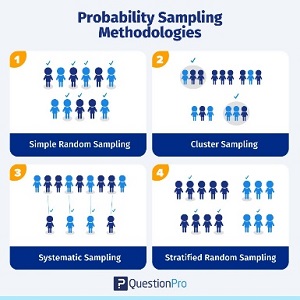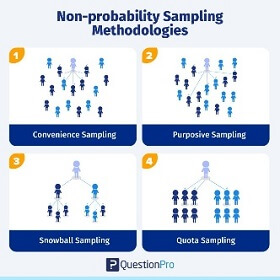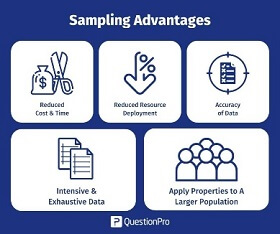Sample DefinitionHow frequently do researchers hunt for the appropriate survey participants for a market research study or an already conducted survey in the field? The sample or respondents for this study may be chosen from a group of known or unknowing consumers or customers. Often times, even though you are aware of the typical respondent profile, you cannot complete your research project without the respondents. In these circumstances, researchers and research teams get in touch with specialised organisations to use their respondent panel or purchase respondents from them to finish research studies and surveys. They could be respondents from the general population who meet the demographic requirements or those who meet certain criteria. The success of research investigations depends on these responders. The many sample types, sampling techniques, and representative instances are covered in length in this page. Additionally, it describes how to compute the size, provides information about an online sample, and highlights the benefits of employing them. What is a Sample?A sample is a condensed set of information that a researcher selects or picks from a broader population using a predetermined technique of selection. These components are referred to as observations, sampling units, or sample points. Developing a sample is a productive way to carry out research. The entire population must frequently be studied, which is difficult, expensive, and time consuming. As a result, studying the sample offers information the researcher can use to understand the complete population. For instance, a cell phone manufacturer might want to interview students at American universities about certain features. If the researcher wants to find features that students utilise, features they would want to see, and the price they are prepared to pay, an extensive research study must be carried out. It is crucial to complete this step in order to comprehend the features that need to be developed, those that need to be upgraded, the device's price, and the go-to-market plan. There were 24.7 million students enrolled in American universities in 2016-17 alone. It is impossible to investigate all of these pupils; the time and money required to do so would render the study meaningless and the new technology unnecessary. A sufficient sample of students for study can be obtained by selecting universities based on their geographic location and then selecting a subset of their students. The population for market research is typically rather large. The entire population cannot be counted, in all likelihood. Typically, the sample represents a sizeable portion of this population. Surveys, polls, and questionnaires are then used by researchers to gather data from these samples, and this data analysis is extrapolated to the larger community. Types of Samples: selection methodologies with examplesA sampling method is the procedure used to get a sample. While this technique generates the quantitative and qualitative data that can be collected as part of a research study, sampling plays a crucial role in the research design. Probability sampling and non-probability sampling are two separate approaches to sampling techniques. Examples of probability sampling techniquesThe process of obtaining a sample through probability sampling involves choosing the objects from a population according to probability theory. Everyone in the population is included in this technique, and everyone has an equal chance of getting chosen. Hence, there is absolutely no bias in this kind of sample. The research can then involve every member of the population. The selection criteria are chosen at the beginning of the market research study and are a crucial part of the investigation. Four different types of samples can be used in probability sampling. They are: 
1. Simple random sampling This method of sample selection is the easiest to understand. Each participant has an equal chance of taking part in the study using this strategy. Each member of this sample population has an equal chance of being chosen at random to become an object. For instance, if a university dean wanted to gather input from students about how they felt about the professors and their level of education, this sample could include all 1000 students at the university. To create this sample, 100 students can be chosen at random from any class. 2. Cluster sampling A sample technique called cluster sampling divides the respondent population into equal clusters. Based on defining demographic factors like age, location, sex, etc., clusters are found and included in a sample. This makes it incredibly simple for a survey developer to draw useful conclusions from the responses. For instance, if the FDA wishes to gather information on negative drug side effects, it can divide the US mainland into distinct clusters, such as states. Respondents in these clusters are subsequently given research surveys. Using this method of sample generation, comprehensive data collection and easily actionable information are provided. 3. Systematic sampling By using systematic sampling, a population is sampled by randomly selecting respondents at equal intervals. Picking a beginning point and then choosing responders at a predetermined sample interval is the method for choosing the sample. As an illustration, when choosing 1,000 volunteers for the Olympics from a list of 10,000 applicants, each applicant is assigned a count between 1 and 10,000. Then a sample of 1,000 volunteers can be obtained by counting backwards from 1 and selecting each respondent with a 10-second interval. 4. Stratified random sampling In the research design phase, stratified random sampling is a technique for segmenting the respondent population into discrete but pre-defined parameters. The responders in this method don't overlap; rather, they speak for the entire population as a whole. For instance, a researcher examining persons from various socioeconomic backgrounds can identify respondents based on their yearly earnings. Afterward, some of the objects from these samples can be employed for the research study. This creates smaller groups of persons or samples. Non-probability sampling methodologies with examplesThe researcher's judgement is used to choose a sample in the non-probability sampling technique. This kind of sample is primarily determined by the researcher's or statistician's capacity to access it. When conducting preliminary research, this kind of sampling is employed since the main goal is to generate a hypothesis regarding the research issue. Here, each participant does not have an equal probability of being in the sample population, and the sample is only made aware of these parameters after it has been chosen. Non-probability sampling can be divided into four different kinds of samples. They are: 
1. Convenience sampling In plain English, convenience sampling refers to the ease with which a researcher can contact a respondent. The method used to create this sample is not scientific. The selection of the sample components is done only on the basis of proximity, not representativeness, and the researchers have almost no control over it. When there are time and financial constraints on gathering feedback, this non-probability sampling method is used. As an illustration, consider researchers who are conducting a mall-intercept study to determine the likelihood that people will use a fragrance produced by a perfume business. Based on their closeness to the survey desk and desire to engage in the study, the sample respondents in this sampling technique are selected. 2. Judgemental/purposive sampling The judgmental or purposive sampling approach is a way of selecting a sample based only on the researcher's judgement and understanding of the target audience, the nature of the study, and other relevant factors. Only those individuals who meet the research criteria and end goals are chosen using this sample technique, while the rest are excluded. If the research question is "Would you like to do your Masters?" and the only acceptable response is "Yes," then everyone else is not included in the study. As an illustration, if the research question is "What University do you prefer as a student for Masters?" 3. Snowball sampling A non-probability sampling method where the samples have uncommon characteristics is known as snowball sampling or chain-referral sampling. This sampling method uses recommendations from current participants to find the sample populations needed for a study. For instance, when asked for feedback on a touchy subject like AIDS, respondents are reticent to provide details. In this situation, the researcher can enlist individuals who have expertise or understanding of such individuals and ask them to gather information on behalf of the researcher. 4. Quota sampling With quota sampling, the researcher is free to choose the sample they want to use based on their stratification. This method's main characteristic is that two persons cannot coexist in two different environments. For instance, a shoe producer could want to comprehend how millennials view the brand in relation to other factors like comfort, cost, etc. For this study, it solely chooses female millennials because the goal is to gather opinions on women's shoes. How to determine a Sample SizeAs we learned above, choosing the appropriate sample size is crucial for the data collection process in a market research study. Is there a precise estimate of the sample size, though? How is the sample size determined? What are the survey's methods of distribution? It is initially imperative to comprehend four significant aspects that constitute the fundamental characteristics of a sample in order to fully comprehend all of this and calculate the appropriate sample size. They are:
Calculating sample sizeYou require the following variables to determine the sample size:
You can use this formula to determine the sample size: Sample Size = (Z-score)2 * StdDev*(1-StdDev) / (margin of error)2 Consider the confidence level of 90%, standard deviation of .6 and margin of error, +/-4% ((1.64)2 x .6(.6)) / (.04)2 (2.68x .0.36) / .0016 .9648 / .0016 603 Your sample size is determined by the required number of respondents-603. Sampling Advantages
The advantages of sampling are numerous, as was just mentioned. Among them, the most important benefits are: 1. Reduced cost & time Using a sample cut down on the amount of people that need to be contacted, which cuts down on both cost and time. When compared to performing a research study with a sample, consider how much time can be saved. 2. Reduced resource deployment It goes without saying that the resources needed will be significantly lower if there are significantly fewer participants in a research study as a result of the sample. Compared to studying the entire population, a lot smaller workforce is required for the research on the sample. 3. Accuracy of data The information gathered is accurate because the sample represents the population. Also, the survey dropout rate is substantially lower because the respondent is willing to participate, which improves the validity and quality of the data. 4. Intensive & exhaustive data Because there are fewer responders, a sample's data collection is intense and detailed. Rather than gathering information from a large number of people, more time and effort are spent on each response. 5. Apply properties to a larger population It is safe to say that the information gathered and examined from the sample can be applied to the wider population because the sample is representative of the larger population, which would hold true. ConclusionIn summary, a sample is a portion of a population that is used to gauge the traits of the whole group. Sampling is crucial to research and data analysis in order to draw conclusions about a population based on a smaller sample size. There are various kinds of sampling, including probability sampling, non-probability sampling, and others, and each has benefits and drawbacks of its own. It's critical to select the appropriate sample technique based on the research topic, budget, and available resources. Also, the accuracy and generalizability of the results are greatly influenced by the sample size. This article has given a thorough understanding of sampling's definition, kinds, formula, and examples. Researchers and analysts can perform more effective study and data analysis by understanding the various types of sampling and the formulae used to compute sample size. Sampling is a crucial method that enables researchers to draw conclusions about a community from a smaller sample size of people. Researchers can guarantee the accuracy and generalizability of their findings by using the proper sampling technique and sample size. One of the worst errors you can make when generating online surveys for your customers, staff, or students is asking the incorrect questions. For their surveys, many firms and organisations have varied needs. Participants are more likely to leave the survey early if you ask them irrelevant questions. Using a sample questionnaire template can help you prepare for a productive survey.
Next TopicService Definition
|
 For Videos Join Our Youtube Channel: Join Now
For Videos Join Our Youtube Channel: Join Now
Feedback
- Send your Feedback to [email protected]
Help Others, Please Share










